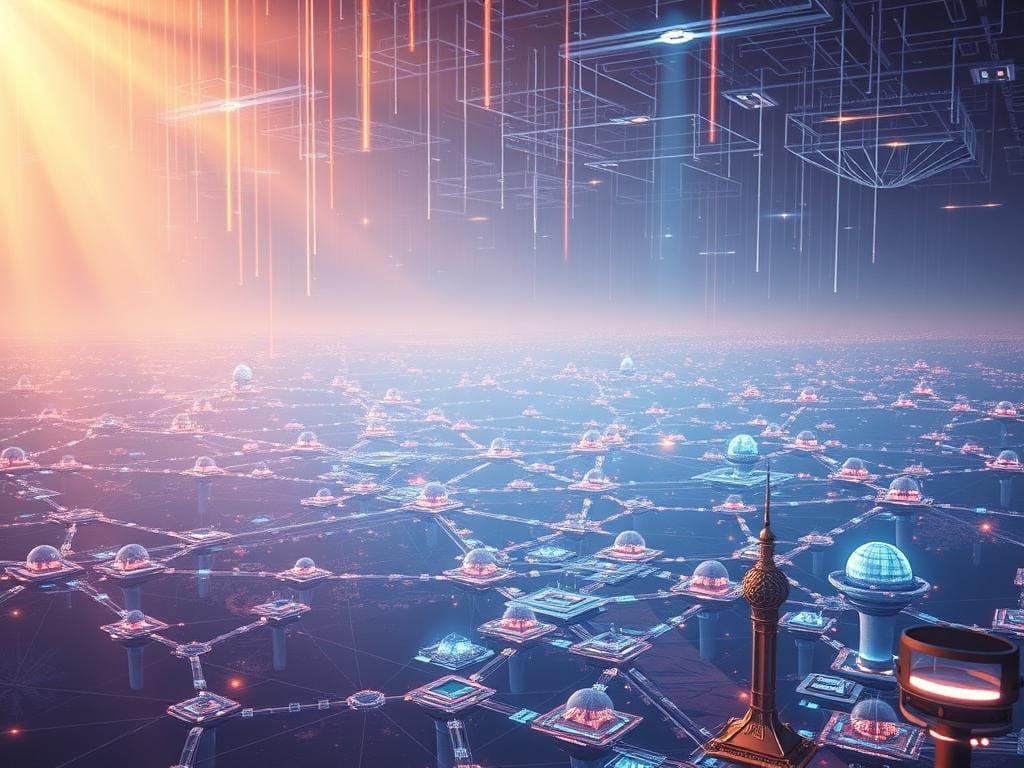You’re on the edge of a gaming revolution that will change how you play games. The metaverse, a single virtual world, will mix games with other experiences. This will change how games are made, played, and made money from.
Picture a world where virtual reality and augmented reality blend together. This will create deep, real-like experiences that take you to new places. The metaverse is bringing this future to life.
Key Takeaways
- The metaverse is set to revolutionize the gaming industry.
- Gaming experiences will become more immersive with VR and AR.
- Game design, play, and monetization will undergo significant changes.
- Gamers can expect more interactive and engaging experiences.
- Developers will need to adapt to new technologies and trends.
Understanding the Metaverse Concept
Imagine a world where virtual and augmented realities blend into an immersive experience. Welcome to the metaverse. It’s a future version of the internet as a universal virtual realm. Here, users interact in a three-dimensional virtual environment.
Definition and Key Features
The metaverse offers immersive experiences through virtual reality (VR) and augmented reality (AR). It’s a digital environment that’s not just interactive but also stays alive even when you’re not there.
Key features of the metaverse include:
- Interoperability across different platforms
- A vast, user-generated content ecosystem
- Advanced social interactions that mimic real-life experiences
- Evolving economies with real-money transactions
Neal Stephenson, who coined the term “metaverse” in his 1992 novel Snow Crash, envisioned it as a virtual reality-based immersive experience. Today, it includes VR, AR, and cross-platform unity.
Historical Context and Evolution
The idea of the metaverse has been around for decades. But recent tech advancements have made it closer to reality. From early online gaming to today’s VR and AR, the metaverse is the next step in the internet’s evolution.
“The metaverse is a future version of the internet, made up of persistent, shared, 3D virtual spaces that are part of a virtual universe.”
The metaverse is set to change how we interact with digital worlds. It promises a more immersive and interactive experience. As we move forward, understanding the metaverse will be key to seeing its impact on gaming and beyond.
How the Metaverse is Reshaping Gaming
The metaverse is changing the gaming world with immersive experiences we never thought possible. As you explore metaverse gaming, you’ll see how virtual reality makes games feel real.
Immersive Experiences and Virtual Reality
The metaverse’s 3D world is taking gaming to new heights. Virtual reality lets you explore vast virtual worlds that feel real. For more on gaming’s future, check out this article on the metaverse’s impact.
Gaming is getting more interactive. You can now interact with games in ways we couldn’t before. VR is making games more immersive and fun.
Cross-Platform Play and Interoperability
Cross-platform play is a big deal in metaverse gaming. It lets you play with others on different devices. This means you can play the same game on any device, without any hassle.
The metaverse also makes games work together better. As talked about in 5G mobile development, playing games across platforms is the future. It makes the gaming community stronger.
Benefits of the Metaverse for Gamers
The metaverse is changing how we play games and interact with others. It brings a new level of fun and connection.
Enhanced Social Interaction
The metaverse makes games more interactive and social. You can meet friends and other players in real-time. This builds a strong sense of community and teamwork.
For example, you can join virtual events, form groups, or even create your own spaces. This shows how the metaverse is redefining multiplayer experiences.
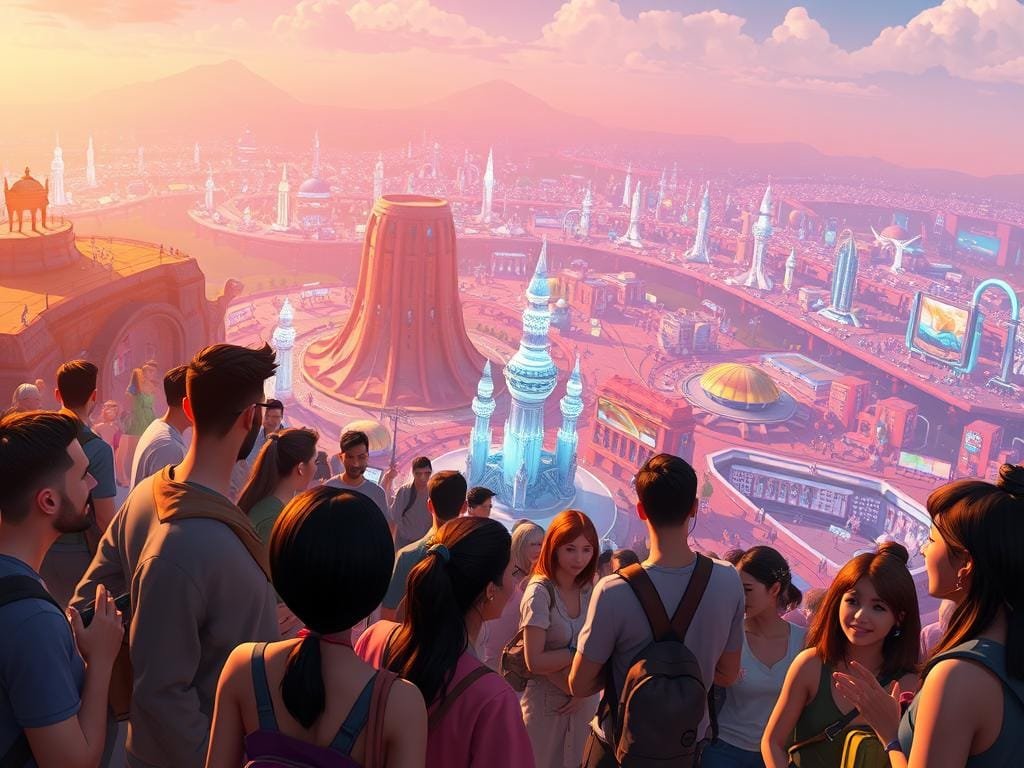
Unlimited Content Creation
The metaverse lets you create unlimited content. With the right tools, you can make your own games and worlds. This encourages creativity and innovation.
To learn more about the metaverse’s benefits and challenges, check out this resource. It offers a detailed look at the metaverse’s advantages and disadvantages.
| Feature | Traditional Gaming | Metaverse Gaming |
|---|---|---|
| Social Interaction | Limited to pre-defined multiplayer modes | Enhanced social features, real-time interaction |
| Content Creation | Restricted to game developers | Open to all players, unlimited possibilities |
The Developer’s Perspective on the Metaverse
As a developer, you’re on the cusp of a revolution in game development, thanks to the metaverse. The metaverse is not just a new platform; it’s a vast, interconnected virtual world. It opens up new avenues for creativity and innovation in game design.
The flexibility of the metaverse allows you to create games that can be played across various devices and interfaces. This removes the constraints of physical hardware. You can design experiences that dynamically shift between different mediums. This offers players a more versatile and engaging experience.
New Opportunities for Game Design
The metaverse enables you to push the boundaries of game design in several ways:
- Create immersive, interactive worlds that players can explore in depth.
- Develop games that incorporate elements from the physical world, using technologies like AR (Augmented Reality).
- Design games that are not limited by the constraints of a single platform or device.
With these opportunities, you can craft unique gaming experiences. These experiences can captivate players and set new standards in the industry.
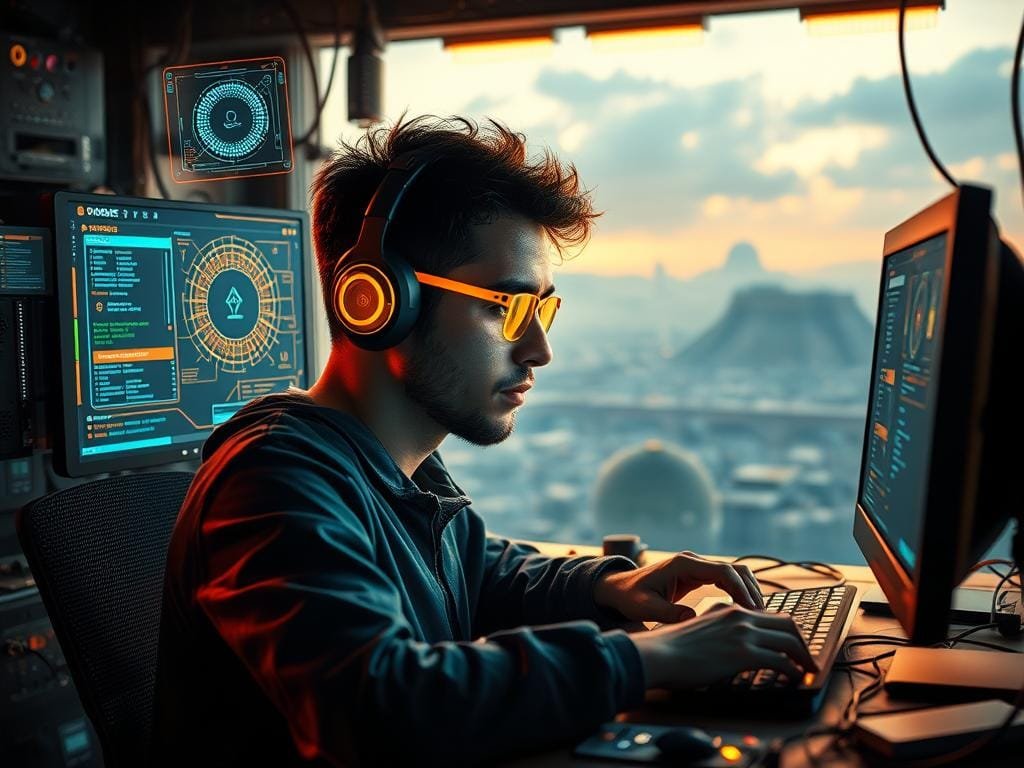
Potential Revenue Models
The metaverse also introduces new revenue models for game developers. You can explore various monetization strategies, such as:
- Subscriptions: Offer players access to premium content, exclusive experiences, or regular updates for a recurring fee.
- Micropayments: Allow players to purchase in-game items or currency. This enhances their experience without requiring a large upfront cost.
- Virtual Goods Sales: Create and sell unique digital goods, such as custom avatars, skins, or other virtual items.
By leveraging these revenue models, you can create a sustainable and profitable business in the metaverse.
Notable Metaverse Game Platforms
Metaverse technology is being led by platforms like Roblox and Fortnite. These platforms are changing the gaming world. They are also changing how we interact in virtual spaces.
Roblox: Empowering Young Developers
Roblox is a popular metaverse game platform for young people. It lets young developers create and make money from their games. This encourages creativity and innovation.
Key Features of Roblox:
- User-generated games with a wide range of genres
- Monetization options through in-game purchases and advertisements
- A strong community of developers and players
Fortnite: A Cultural Phenomenon
Fortnite is a cultural hit, known for its interactive events and virtual concerts. It mixes gaming with social interaction, giving players a unique experience.
Notable Features of Fortnite:
- Regular updates with new content and events
- Interactive experiences, including virtual concerts and movie screenings
- A vast and active community of players
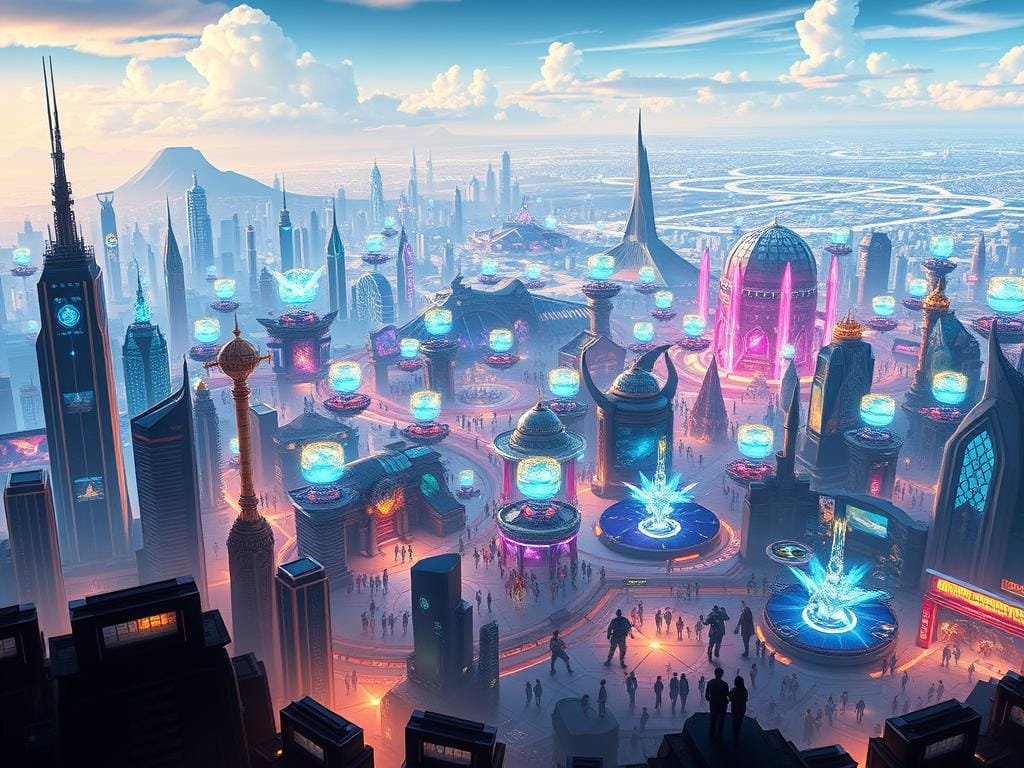
The impact of these platforms on the metaverse is huge. They are preparing the ground for future virtual space technology.
| Platform | Key Features | User Base |
|---|---|---|
| Roblox | User-generated games, monetization options | Younger audiences, developers |
| Fortnite | Interactive events, virtual concerts | Wide range of gamers, cultural enthusiasts |
As the metaverse grows, Roblox and Fortnite will be key players. Their fresh takes on gaming and virtual interaction are opening up new experiences in the metaverse.
Challenges Facing the Metaverse
The metaverse is growing, but it faces many challenges. It’s a complex digital world that needs strong solutions to overcome these obstacles.
Security and Privacy Concerns
Security and privacy concerns are big issues for the metaverse. As people spend more time online, the risk of data breaches grows. Keeping user data safe and private is key to building trust.
“The metaverse will require a new level of security and privacy to protect users and their data.”
Developers must use advanced security like encryption and secure login systems. This will help protect user information.
Technical Limitations and Accessibility
The metaverse also struggles with technical limitations and accessibility issues. Current technology can make it hard for some to use virtual worlds. Better VR and faster internet are needed to solve these problems.

It’s also important to make the metaverse accessible to all. This means creating easy-to-use interfaces and supporting users with disabilities.
Overcoming these challenges is vital for the metaverse’s success. By working together, we can build a safe, welcoming digital space for everyone.
The Future of Game Development in the Metaverse
The metaverse is changing the way we play games, opening up new paths for developers. As this virtual world grows, it’s important to know what’s trending in game making. Also, how community feedback shapes this new world.
Trends to Watch in Game Creation
Several trends are shaping game development in the metaverse. Immersive experiences are becoming more common, thanks to VR and AR. Developers are also working on interconnected game worlds, making it easy to move between different games.
Another big trend is adding social interactions to games. This lets players connect in deeper ways. The metaverse is set to make social gaming even more complex and fun.
Importance of Community Feedback
Community feedback is key in the metaverse. It helps developers know what players like and need. By talking to the gaming community, developers can improve their games.
For example, Roblox shows how important community involvement is. It lets users create and share games, creating a community that drives innovation.
The metaverse will keep growing thanks to community feedback. It’s vital for developers to keep talking to players. This way, games in the metaverse will meet the community’s needs and expectations.
Economic Implications of the Gaming Metaverse
The gaming industry is changing with the metaverse. This virtual world is opening up new chances for gamers and developers.
Virtual Economies and Real Money Transactions
The metaverse is growing virtual economies. Players can now buy, sell, and trade digital items and services. Some players make real money from their gaming activities.
Key aspects of virtual economies in the metaverse include:
- Digital goods and services
- Virtual real estate
- In-game currencies
But, there are challenges too. Market volatility and exploitation are concerns. They need to be fixed for a fair economy.
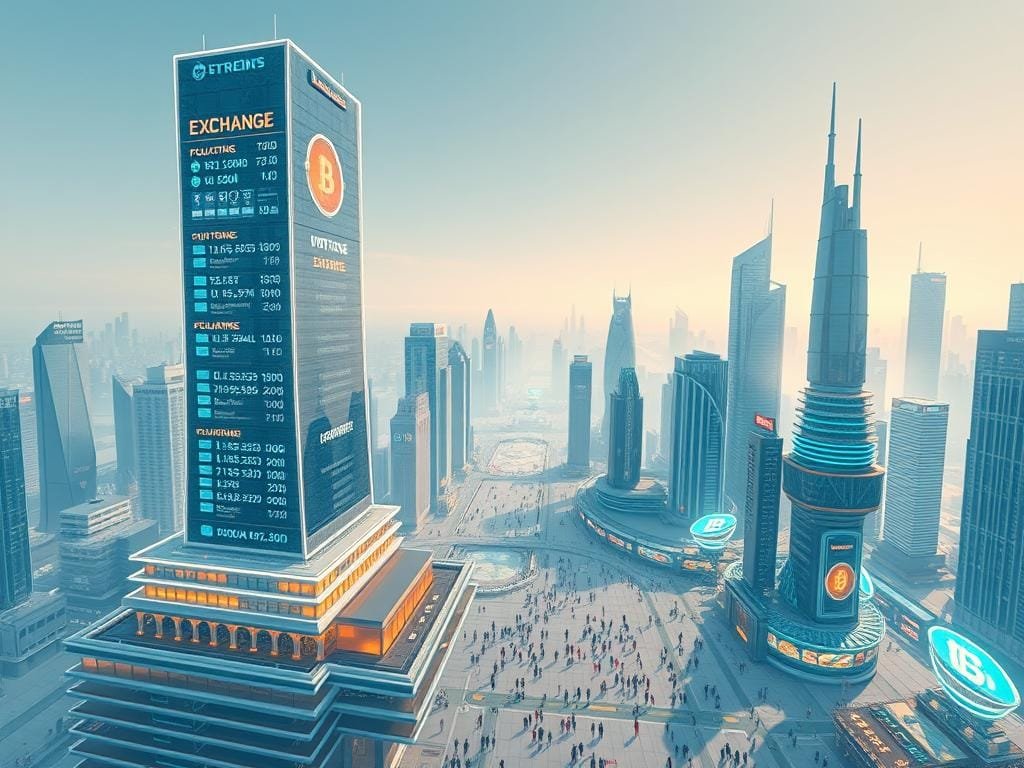
Job Creation in the Gaming Industry
The metaverse is creating new jobs in gaming. Roles like game developers, virtual event managers, and digital goods designers are emerging. It’s opening up new career paths.
Some of the emerging job roles in the metaverse include:
- Virtual event coordinators
- Digital asset creators
- Community managers
- Game designers specializing in metaverse experiences
As the metaverse grows, more jobs will appear. This will expand the gaming industry’s economic impact.
In conclusion, the metaverse has big economic effects. It can create new income streams and jobs. As it evolves, it’s key for everyone to work together to make sure these benefits are shared.
Gamers’ Engagement in Metaverse Ecosystems
The metaverse is changing the game, enabling you to participate in dynamic, virtual worlds. This shift is largely driven by innovative engagement models that blur the lines between gaming and real life.
One of the key drivers of engagement in metaverse ecosystems is the implementation of play-to-earn models. These models allow players to earn rewards, often in the form of cryptocurrency or NFTs, by participating in games and contributing to the ecosystem. As Forbes notes, “Play-to-earn gaming has the potential to create new economic opportunities for players around the world.”
Play-to-Earn Models and Incentives
Play-to-earn models are revolutionizing the way you interact with games. By providing tangible rewards, these models encourage participation and build a sense of community. For example, games like Axie Infinity have made it possible for players to earn cryptocurrency by playing and contributing to the game’s ecosystem.
As the metaverse evolves, the incentives from play-to-earn models will likely become more advanced. This could include:
- Unique digital assets that can be traded or sold
- Exclusive in-game content or privileges
- Governance tokens that allow players to influence game development
Gamification of Everyday Activities
Beyond gaming, the metaverse is also driving the gamification of everyday activities. It makes daily tasks more engaging by adding game-like elements. For example, fitness apps that reward users with virtual tokens for completing workouts are becoming increasingly popular.
As gamification becomes more prevalent, it will likely change various aspects of your daily life, from education to productivity. The metaverse enables a seamless integration of these elements, creating a more interactive and immersive experience.
“The gamification of everyday activities has the potential to make a significant impact on our daily lives, making tasks more enjoyable and rewarding.” –
By leveraging play-to-earn models and gamification, the metaverse is creating new opportunities for engagement and interaction. As you explore these ecosystems, you’ll discover a more immersive and dynamic gaming experience that extends beyond traditional boundaries.
The Role of Blockchain Technology
Blockchain technology is key to the metaverse, making decentralization and true ownership of virtual assets possible. As you explore metaverse gaming, knowing how important blockchain is becomes vital.
Decentralization and Ownership
Blockchain’s decentralized nature makes transactions in the metaverse secure, open, and unchangeable. This decentralization lets users control their digital assets and identities. It creates a more democratic and open space where ownership is guaranteed.
To learn more about blockchain and the metaverse, check out https://rejolut.com/blog/metaverse-and-blockchain/. It offers detailed insights into how these technologies work together.
NFTs in the Gaming Metaverse
Non-Fungible Tokens (NFTs) are changing the gaming metaverse by adding a new level of ownership and rarity. NFTs let gamers buy, sell, and trade unique digital items, making the game better. Blockchain technology makes sure these deals are safe and that ownership is clear.
NFTs in the gaming metaverse are more than a trend; they’re a major change in how gamers interact with virtual worlds. As the metaverse grows, NFTs and blockchain will play bigger roles. They will open up new chances for gamers and developers alike.
Key Players in the Metaverse Gaming Space
Metaverse gaming is growing fast, thanks to big names in the field. These companies are making virtual worlds more exciting and real. They’re pushing what’s possible in gaming.
Companies Leading the Charge
Meta Platforms, Epic Games, and Roblox are leading the way. They’re investing in making games and worlds that everyone can enjoy. Their work is making virtual experiences more real and fun.
Meta Platforms is focusing on making social interactions in the metaverse better. Epic Games is using its game-making skills to create amazing virtual worlds. Roblox lets users make their own games and experiences.
Collaborations and Partnerships
Working together is key for the metaverse’s growth. Companies share knowledge and cut costs by teaming up. This makes virtual worlds more engaging and robust.
By visiting Digital Vista Online, you can learn more about virtual worlds. They have many uses in different industries.
| Company | Focus Area | Notable Initiatives |
|---|---|---|
| Meta Platforms | Social Interactions | Developing virtual reality tools for social gatherings |
| Epic Games | Game Development | Creating immersive gaming experiences with Unreal Engine |
| Roblox | User-Generated Content | Empowering users to create and share their own games |
As the metaverse grows, we’ll see more teamwork and innovation. The future of metaverse gaming looks bright. It promises endless possibilities for immersive experiences and virtual interactions.
Preparing for the Metaverse Transition
The metaverse is changing fast, and gamers and developers must get ready. It’s like a 3D internet and a virtual world that could be worth trillions. To move into this new space, you’ll need to learn about new tech and ways of doing things.
Gamer Adaptation Strategies
Gamers will have to get used to new ways of interacting. Start by checking out places like Sotheby’s digital auction house. It’s already making waves in the virtual world.
Resources for Developers
Developers need tools and support to make content for the metaverse. Look into online courses and certifications, like those from Digital Vista Online. They offer skills in cloud tech, machine learning, and more. This will help you succeed in the metaverse.
FAQ
What is the metaverse and how does it relate to gaming?
The metaverse is a future version of the internet. It’s a unified virtual world where users interact in 3D. This changes gaming by making experiences more immersive and allowing cross-platform play.
How does the metaverse enhance social interaction in gaming?
The metaverse helps build communities and supports teamwork. Gamers can connect in a shared virtual world, no matter their device. This boosts social interaction.
What benefits does the metaverse offer to gamers in terms of content creation?
The metaverse lets gamers create endless content. This enriches gaming and offers new ways to engage with games.
How is the metaverse changing game development and revenue models?
The metaverse introduces new game design and revenue models. Developers can make games for various devices. This opens up new ways to earn money through subscriptions and virtual goods.
What are some notable examples of metaverse game platforms?
Roblox empowers young developers, while Fortnite has made a big cultural impact. Both show the metaverse’s power to change gaming.
What challenges is the metaverse facing, and how can they be addressed?
The metaverse faces issues like security, privacy, and accessibility. Developers and stakeholders must work together to create a safe, inclusive space.
How will the metaverse impact the future of game development?
The metaverse will shape game development with new trends and community feedback. Developers will need to adapt to these changes to use the metaverse’s full capabilities.
What are the economic implications of the gaming metaverse?
The metaverse could lead to virtual economies and real money transactions. It also creates new job opportunities in gaming.
How does blockchain technology contribute to the metaverse?
Blockchain technology offers decentralization and ownership through NFTs. It ensures secure, transparent transactions and gives users true ownership of virtual assets.
Who are the key players in the metaverse gaming space?
Meta Platforms, Epic Games, and Roblox are leading the metaverse. They are pushing innovation through partnerships and collaborations.
How can gamers and developers prepare for the metaverse transition?
Gamers need to get used to new interfaces and experiences. Developers require resources and support to create metaverse content. This will help with a smooth transition.
